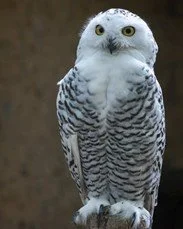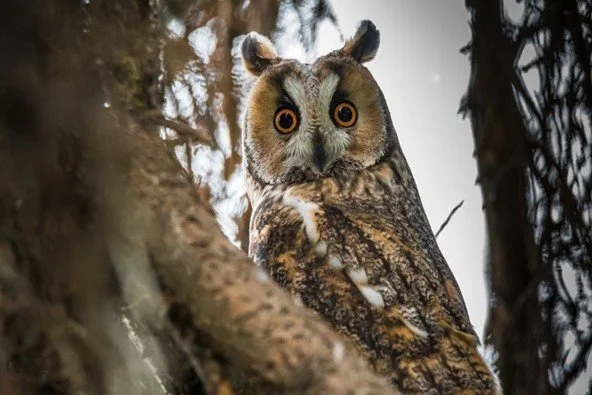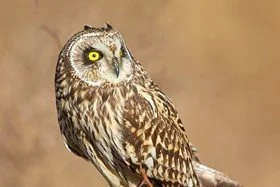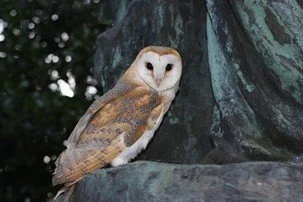Who's Hooting Around?
—Julia Koch, Environmental Educator
Owls are some of the most beloved raptors; their silent flight, large eyes, mournful calls, and nocturnal behavior makes them both magical and mysterious. The owl has come to symbolize many different things: carrier of wisdom, messenger to the spirit world, harbinger of death, even fortune in battle. Owls are carnivorous, more often heard than seen. In New York, some owls live here year-round, and some are migratory, the majority are active at night. Keep reading to find out the eight types of owls to look out for.
Snowy Owl: The yellow-eyed snowy owl is a rare winter visitor, migrating from their Arctic home to our area sporadically, depending on their population and food source. These majestic owls are white and flecked with a dusky color, camouflaging them perfectly against snow. They have smoothly rounded heads with no ear tufts. Because they perch low or on the ground, they are commonly seen in open areas like fields, marshes, beaches, airports, and frozen lake shores. The females are much darker than the males. Interestingly, these owls seem to get whiter with age. You may remember this owl from Harry Potter—his pet owl, Hedwig, is a snowy owl.
2. Great Horned Owl: With its prominent earlike tufts (or “horns”), intimidating yellow-eyed stare, and deep hooting voice, the Great Horned Owl is the quintessential owl of storybooks. They are the largest owl in the state, mottled gray/brown with reddish brown faces. These powerful owls like diverse, wooded habitats, including suburban areas. They may nest in a variety of sites, including old nests of other birds, snags, and large tree hollows. They are year-round residents in this area. These birds advertise their territories with deep, soft hoots with a stuttering rhythm: hoo-h; HOO – hoo-hoo.
3. Eastern Screech Owl: A year-round resident, the Eastern-Screech Owl is a short, stocky bird with yellow eyes, little horns, a large head, and almost no neck. Their horns/ear-tufts are not used for hearing. Owls have ears on the sides of their heads, below their feathers, parallel with their eye line. The tufts are used to communicate with other owls for safety, to a mate or, to intimidate a competitor. Some are gray and others are reddish, allowing them to blend in with trees. These birds prefer a mix of woods, open areas, and water and you can find them nesting or roosting in holes in trees, nest boxes, and even on top of streetlamps. Their most common sound is an even-pitched trill, often called a tremolo.
4. Long-Eared Owl: A secretive, slender nocturnal owl, the long-eared owl often perches immobile next to tree trunks, appearing invisible because of their superb camouflage--they are extremely hard to spot! These owls have long ear tufts, a reddish-brown facial disk, yellow-orange eyes, and dark-feathered bodies. Males are often paler than females. Long-eared owls roost communally in dense foliage like winter evergreens, forming colonies of up to 100 individuals. A rare nester, these owls often use old crow nests in conifers in open woodlands, plantations, and wooded swamps. The long ear tufts that stick straight up from this owl's head give it an expression of permanent surprise. Their typical call sounds like a low “hoo,” evenly spaced every few seconds.
5. Barred Owl: The barred owl is a year-round resident, so named because of the brown and white bar patterned feathers that cover their body. They are large, dark-eyed, gray-brown birds and have round heads without ear tufts. They prefer densely forested areas for breeding. These birds nest in tree cavities or in old hawks, squirrels, or crow nests. They have a distinctive hooting call, described as, “Who cooks for you? Who cooks for you all?”
6. Northern Saw-Whet Owl: This is the state’s smallest owl, known for their wide, orange-yellow eyes. This bird gets its name from one of its calls that sound like a saw being sharpened. They are nocturnal and can be found nesting in holes in trees (often woodpecker cavities), dense forests, wooded swamps, bogs, and forest edges. This is the species of owl that was discovered hidden in the Rockefeller Center Christmas tree in New York City during the 2020 holiday season. Northern Saw-Whet Owls have a distinctive too-too-too song, given at a rate of about two notes per second.
7. Short-Eared Owl: The rare, medium-sized Short-Eared Owl is the most diurnal (active during the day) of all the owls discussed in this article. They are usually seen during the day hunting small mammals in open grassland areas with little cover, like old fields, marshes, airports, and meadows. These streaked owls have yellow eyes, round, beige facial disks like those of barn owls, and their underparts are white/buff (male) or tawny/rust (female). They nest on the ground in open areas like marshes and fields along the coast. They are listed as an endangered species in New York due to habitat loss.
8. Barn Owl: This medium-sized, almost completely nocturnal owl has a white belly, pale brown wings, dark eyes, and long legs. Though the easiest way to identify the barn owl is by its white heart-shaped face with a dark brown edge. You can find them after dark flying low over open fields, grasslands, and marshes, listening for small mammal prey scurrying below. They have the best ability of any animal to locate prey by sound alone! Their nesting cavities range from trees and barns to silos and cliff crevices. You can even find them in man-made nest boxes. These owls don’t hoot--they make unique, screechy sounds.
Want to learn more about birds visiting our backyards this winter? Check out this event happening this Saturday, January 22nd at Marshlands Conservancy in Rye, called Backyard Birds in Winter: Backyard Birds in Winter (westchestergov.com).
Happy Bird Watching!









